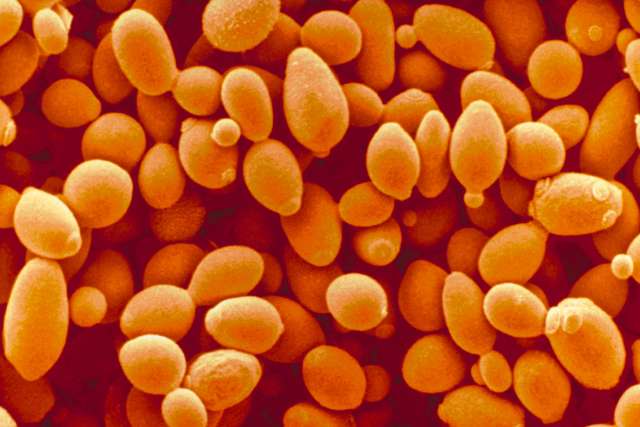FOR MILLENNIA, THE YEAST SPECIES Saccharomyces cerevisiae has been one of humanity’s most useful microbial workhorses — transforming flour into bread, grapes into wine and grain into beer, among other tasks. S. cerevisiae also serves as a handy tool for biologists: a single-celled fungus, easily grown in the lab, whose metabolic processes can serve as a model for those of more complex creatures. And, UCLA researchers say in a study published last year, this organism’s dietary habits may shed light on and potentially lead to new treatments for a genetic disorder that makes dairy products crippling to some people — potentially leading to a host of disabilities that range from intellectual deficits to cataracts — or even deadly.
S. cerevisiae grows best on glucose, a sugar produced by all plants. Although the species can also consume galactose — a breakdown product of lactose, the main sugar in milk — most strains take several hours to activate the genetic pathway that enables them to do so. In recent years, however, scientists have found that some strains, often found in foods like cheese and yogurt, can start processing galactose more rapidly, and grow on it more robustly, than their conventional counterparts. Little is known about the genetic differences that allow dairy-loving strains to metabolize this particular sugar so well.
Unraveling the mysteries of such complex heritable traits is the mission of Leonid Kruglyak, PhD, Diller-von Furstenberg Family Endowed Chair in Human Genetics, Distinguished Professor of Human Genetics and Biological Chemistry and a Howard Hughes Medical Institute investigator. “My lab,” he explains, “uses model organisms and computational analyses to understand how changes at the level of DNA are shaped by molecular and evolutionary forces, and how these changes lead to the observable differences among members of a species.”
In a previous study, Dr. Kruglyak and his team looked for potential associations between DNA variants and inherited traits in more than 10,000 cultures grown from matings among 16 strains of S. cerevisiae. Among the most remarkable results were those involving a soil strain dubbed CBS2888. When this strain was crossed with others, there were striking interactions among three loci (stretches of DNA) known to contain genes crucial to the galactose pathway: some combinations of variants at these loci correlated with much slower than normal growth on galactose.
In the paper published last year, research led by James Boocock, PhD ’21, who was a graduate student in Dr. Kruglyak’s lab at the time and is now a postdoctoral fellow, pushed these findings further. First, the team sequenced CBS2888’s DNA and found that its galactose-related genes were radically different from those of conventional S. cerevisiae. “They could have come from another species altogether,” Dr. Boocock says. “It was like comparing genes from a human and a mouse.”
Next, the researchers used the gene-editing technology CRISPR to engineer strains with every possible combination of the “reference” (conventional) and “alternative” (CBS2888) galactose genes. The strain that grew best on galactose was the one whose genes in all three loci came from CBS2888 — indicating that this soil yeast had somehow evolved to specialize in a sugar typically associated with lactating mammals. The runner-up was the strain whose galactose genes all came from conventional S. cerevisiae.
To the researchers’ surprise, strains with the mixed-and-matched genes from both sources grew poorly.
Puzzled, the team combed through global collections of sequenced S. cerevisiae strains, looking for reference and alternative galactose gene versions — or alleles — outside the lab. Among 1,276 strains, they found two common combinations: only reference alleles (1,213 strains) and only alternative alleles (49 strains). The alternative alleles showed up in dairy products ranging from French Camembert to Chinese fermented yak milk. Missing entirely, however, were strains with mixed alleles, like those the UCLA team had created with CRISPR. If such strains ever existed in nature, they have apparently died out.
Based on this evidence, the researchers theorized that evolution had maintained the different versions of the galactose pathway through “balancing selection” — a process that preserves alternative alleles when each version provides a species with a survival advantage. The best-known example of this phenomenon is the sickle-cell gene, which generates misshapen red blood cells: While individuals who carry two copies of the gene often die young, those with only one copy typically suffer no symptoms, and they are protected from malaria.
ONE REMAINING QUESTION WAS HOW LONG THE ALTERNATIVE GALACTOSE PATHWAY has existed in S. cerevisiae. When the team analyzed the reference and alternative alleles, they found the split occurred approximately 3.2 billion generations ago — or 10-to-20 million years. “That predates the most recent common ancestor of the Saccharomyces genus,” Dr. Boocock notes. “Ancestral yeasts may have used this pathway to feed on plants with a high galactose content. Or some may have evolved in a cheese-like environment created by mammals suckling their pups.”
So what does all this have to do with human health? The incompatible allele combinations the team identified may provide a model for a rare metabolic disease: classical galactosemia. People with this inherited disorder are unable to metabolize galactose; breast milk or dairy-based formula can kill them in infancy. Even if patients avoid dairy products, the body makes small amounts of galactose on its own, often leading to such ills as growth delays, intellectual disabilities, movement disorders, speech problems and early cataracts.
Galactosemia is caused by mutations in the GALT gene, the human equivalent of a yeast galactose gene that Dr. Kruglyak’s team is studying. “This disease is reminiscent of the ‘sickness’ we see in combination strains grown in the lab,” Dr. Kruglyak says. “Our research could yield insights into its mechanisms, and hopefully suggest avenues for developing treatments.”
